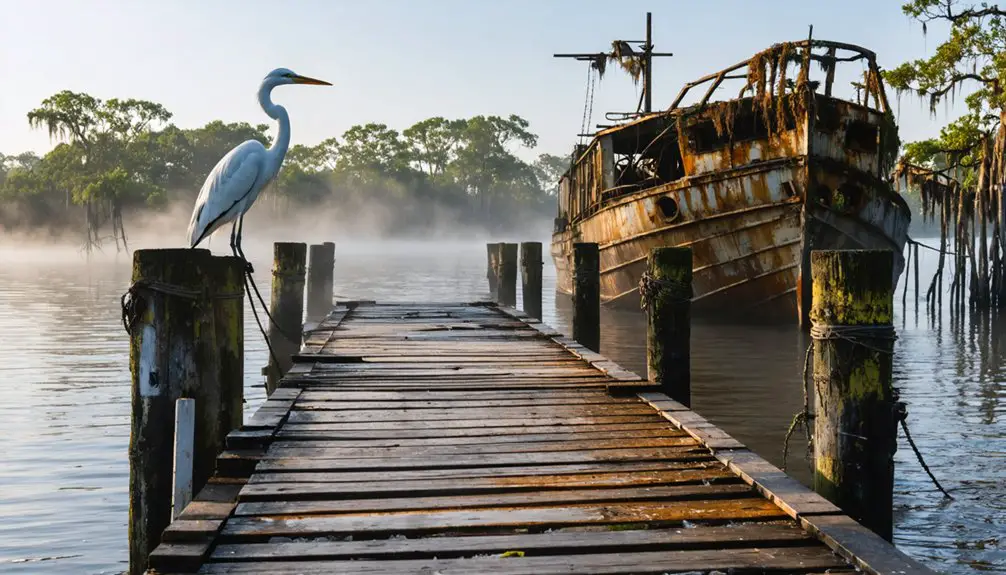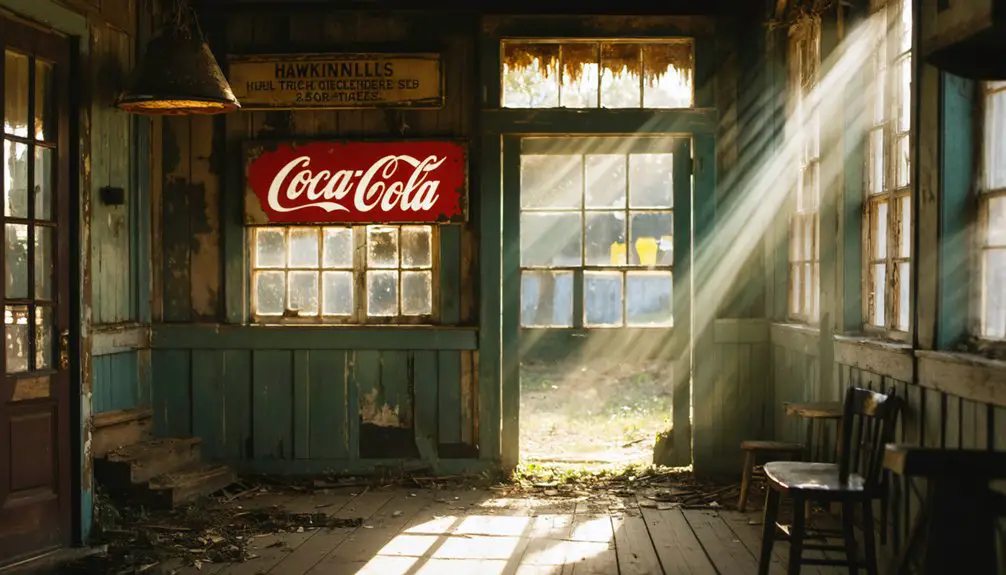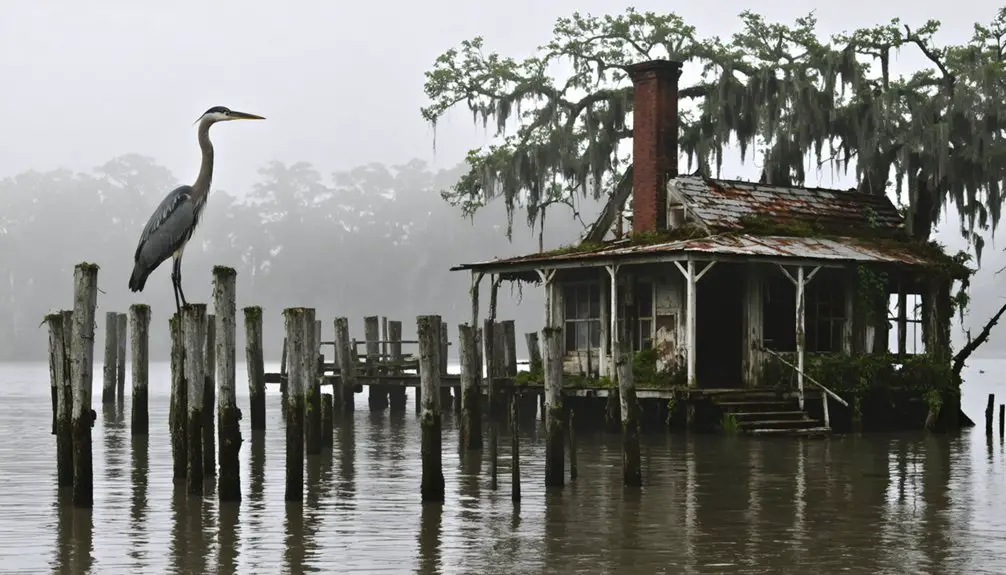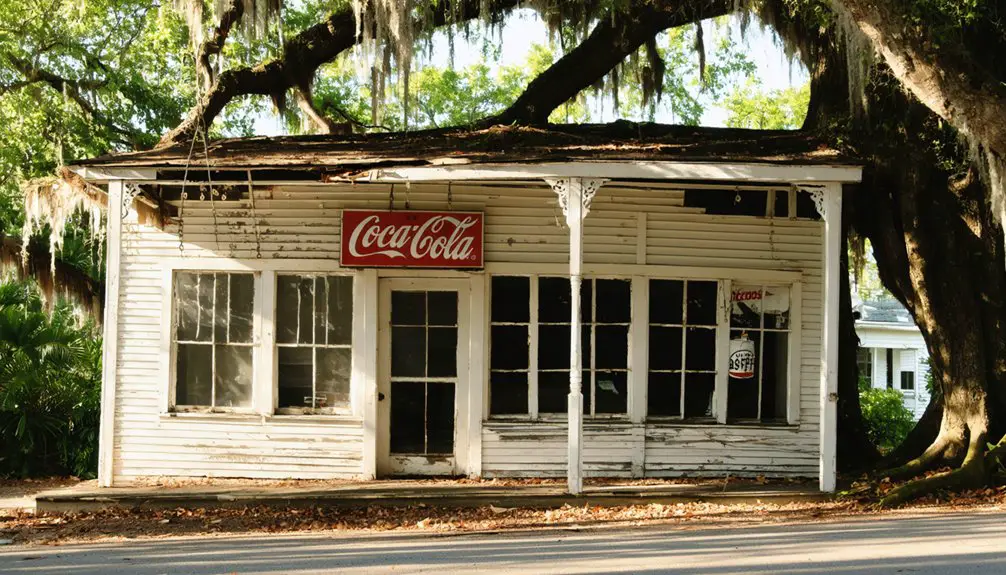You’ll find Hawkinsville along the banks of Florida’s Suwannee River, where steamboats once navigated bustling trade routes in the 1800s. This former river port, established in 1821 by Thomas Hawkins and Joseph A. Dyal, thrived on cotton, lumber, and pecan commerce until railroads redirected trade in the early 1900s. Today, the City of Hawkinsville shipwreck, now Florida’s third Underwater Archaeological Preserve, holds secrets of this ghost town’s maritime past.
Key Takeaways
- Hawkinsville was a thriving 19th-century river port at the confluence of the Suwannee and Ocmulgee Rivers, specializing in cotton and lumber trade.
- The community declined when railroads replaced steamboat transportation in the early 1900s, leading to the abandonment of riverside operations.
- The sinking of the City of Hawkinsville steamboat in 1922 symbolized the end of the town’s maritime prosperity.
- Today, the area exists primarily as an archaeological site, with the steamboat wreck designated as Florida’s third Underwater Archaeological Preserve.
- Local folklore and ghost stories persist around the abandoned settlement, including reports of spectral sightings and mysterious lights near the wreck.
The Rise of a River Trading Post
The town’s position at the confluence of the Suwannee and Ocmulgee Rivers made it perfect for trade network expansion.
You could witness a bustling hub where cotton, lumber, and pecans moved freely between inland territories and coastal ports like Cedar Key.
The port’s growing influence connected previously isolated communities, transforming Hawkinsville into a crucial link in the region’s economic chain.
The area’s maritime heritage was defined by 141-foot steamboats that navigated these waters, facilitating commerce and transportation well into the early 1900s.
The local lumber industry boomed in the aftermath of devastating hurricanes, with steamboats like the City of Hawkinsville transporting timber resources throughout the region.
Early Settlement and Economic Growth
When Colonel John Talcon Lowe secured a Spanish Land Grant of 27,000 acres along the Suwannee River in the early 1820s, he set in motion Hawkinsville’s transformation from wilderness to settlement.
You’ll find that early settlers like Joseph A. Dyal and Thomas Hawkins from Ware County, Georgia, established Pine Grove in 1821, building Florida’s oldest Methodist log church.
While agricultural challenges included devastating floods that damaged farms in 1825, the fertile floodplain supported persistent farming efforts.
The area’s economic foundations emerged from native displacement, as Creek Indian territories gave way to American trading posts and river commerce.
Similar to the Creek Indian Confederacy capital further north, indigenous peoples maintained significant influence in the region before European settlement.
You’ll discover how community cohesion grew around these posts, with lumber operations and steamboat traffic creating a bustling transport hub that preserved the cultural legacy of both native and pioneer inhabitants.
The region’s development paralleled the broader changes occurring after the U.S. purchased Florida from Spain, leading to increased American settlement in the territory.
Maritime Heritage Along the Suwannee
You’ll discover the Suwannee River’s rich maritime history through its essential trade routes, which connected rural communities like Hawkinsville to major ports such as Cedar Key before and after the Civil War.
The 141-foot City of Hawkinsville steamboat, built in 1896, exemplified this era as it transported lumber and supplies between Branford, Clay’s Landing, Old Town, and Cedar Key until its final journey in 1922.
Today, the vessel’s underwater remains near Old Town serve as both a reflection of the river’s commercial significance and a unique heritage tourism site that draws visitors to explore Florida’s steamboat legacy. These historic waterways were vital lifelines that provided mail and supplies to residents throughout eight Florida counties during the nineteenth century.
River Trade Routes
Maritime commerce along Florida’s Suwannee River flourished through a network of scheduled steamboat routes connecting Bayport and Columbus to major Gulf ports like Cedar Key, New Orleans, and Key West.
Cedar Key emerged as a crucial transfer hub, where river navigation met broader Gulf Coast trade networks. You’d find wood-burning sternwheelers transporting cotton, tobacco, peanuts, and naval stores upstream as far as White Springs during high water seasons. The Belle of the Suwannee was among the most notable vessels navigating these trade routes.
The City of Hawkinsville, a 141-foot steamboat built in 1896, exemplified this bustling era, running freight between Branford, Clay’s Landing, Old Town, and Cedar Key.
Before roads and railways dominated transport, these waterways served as fundamental arteries of commerce, with indigenous traders having established extensive routes centuries earlier, reaching destinations as far as Cuba and the Bahamas. Early settlers relied on established ferry crossings to transport their goods and families across these vital waterways.
Steamboat Tourism Impact
During the early 1900s, the City of Hawkinsville pioneered recreational travel along Florida’s Suwannee River, establishing popular routes between Old Town and Fanning Springs.
You’ll find this steamboat heritage preserved today in an underwater archaeological site where the 141-foot vessel rests in shallow waters. The wreck operated as a paddlewheel steamboat for 22 years before its abandonment.
The steamboat’s legacy continues to draw river tourism enthusiasts who can swim directly above the well-preserved wreck. Originally built in Georgia in 1896 by Hawkinsville Deepwater Boat Lines, the vessel transported cotton and naval stores before its relocation to Florida. At depths ranging from 3 to 20 feet, you’ll discover intact features of this remarkable vessel, including its hull, propulsion system, and steam piping.
The freshwater environment has kept the wreck in exceptional condition, offering you a unique glimpse into 19th-century maritime technology.
Through virtual underwater tours and direct exploration, you can experience this essential piece of Florida’s transportation history.
Life in a Bustling Port Town
As you’d walk along Hawkinsville’s bustling waterfront in the early 1900s, you’d encounter crews loading lumber and naval stores onto the City of Hawkinsville while dockworkers managed cargo exchanges between vessels.
You’d notice the constant activity of steamboat engineers maintaining the vessel’s steam engines, deck hands securing cargo, and skilled river pilots planning their routes through the Suwannee’s varying depths. The impressive 141-foot steamboat dominated the waterfront as the largest vessel to ever operate on the Suwannee River.
The waterfront teemed with merchants, laborers, and townspeople whose livelihoods depended on the steady flow of river commerce that connected inland Florida to the Gulf port of Cedar Key.
Daily Maritime Trade Activities
The bustling port of Hawkinsville thrived on daily trade activities centered around the transport of lumber, construction materials, and general supplies along the Suwannee River.
You’d find paddle steamboats like the City of Hawkinsville, stretching 141 feet with two decks, dominating the waterfront as crews managed cargo between vessels and warehouses.
The port’s daily rhythm revolved around precise cargo management and vessel maintenance, ensuring timely deliveries to growing settlements like Branford, Clay’s Landing, and Old Town.
Local laborers loaded lumber for Florida’s expanding railroad industry while unloading construction materials that would build the region’s future.
The port served as a crucial hub where maritime and land transport intersected, supporting a network of merchants, hotels, and services that kept commerce flowing through the Suwannee River region.
Steamboat Workers and Jobs
Life aboard Hawkinsville’s steamboats created a diverse workforce of skilled laborers who kept commerce flowing along the Suwannee River. You’d find captains steering treacherous waters while engineers maintained the crucial steam engines powering massive paddlewheels.
Deckhands and cargo loaders tackled the physical demands of moving lumber and freight, working long hours in Florida’s humid climate.
During the 1900s lumber boom, steamboat labor expanded beyond the vessels themselves. You’d see towboat operators guiding log barges, maintenance crews repairing wooden hulls, and ticket agents managing the constant flow of passengers and cargo between Florida and Georgia.
The river steering skills required were considerable, especially when dealing with shallow waters and seasonal flooding. While railroads eventually displaced these maritime jobs, the steamboat workers’ legacy shaped Hawkinsville’s identity as a bustling port town.
Social Life Along Waterfront
During steamboat operations in early 1900s Hawkinsville, bustling crowds transformed the waterfront into a dynamic social hub where you’d find workers loading cargo, merchants conducting trades, and travelers awaiting passage along the Suwannee River.
You could experience impromptu waterfront gatherings as crews loaded lumber onto the City of Hawkinsville, bound for ports like Branford and Cedar Key.
Local markets and supply shops drew steady streams of river workers, travelers, and residents, creating vibrant exchanges during cargo handling.
River festivals marked seasonal peaks in lumber shipping, bringing waves of traders and workers to town.
This social significance pulsed with each steamboat arrival until the 1920s, when advancing railroads redirected commerce away from the river, leaving Hawkinsville’s once-lively waterfront to fade into silence.
The Legacy of Steamboat Commerce
Steamboat commerce shaped the economic destiny of Florida’s Suwannee River region, with the City of Hawkinsville vessel standing as its most prominent symbol. Built in 1886, this massive paddlewheel steamboat revolutionized trade along the waterways, transporting lumber, cotton, and naval stores between essential ports like Branford and Cedar Key.
You’ll find the evolution of steamboat technology reflected in the vessel’s impressive 141-foot length and dual-deck design.
Yet this economic transformation proved bittersweet – the City of Hawkinsville helped construct the very railroad bridge that would lead to its obsolescence.
Today, you can visit the steamboat’s remains in the shallow waters near Old Town, where it rests as a designated Underwater Archaeological Preserve, evidence of an era when river commerce drove the region’s growth.
Decline of River Transportation

While the City of Hawkinsville once symbolized the region’s commercial significance, the rise of railroads in the early 1900s marked the beginning of river transportation’s decline.
You’d have witnessed a dramatic transportation shift as trains offered faster, cheaper, and year-round service that steamboats couldn’t match. The river decline accelerated when railroads redirected trade from riverside communities, leaving towns like Hawkinsville struggling.
Railroads revolutionized transportation, outcompeting steamboats with superior speed and reliability while redirecting trade away from river towns.
Even as steamboats helped transport materials for railroad bridge construction at Old Town, they were ironically hastening their own demise. By 1922, the dwindling lumber industry and shifting commerce patterns had rendered river transport obsolete.
The once-bustling steamboat culture faded away, leaving behind abandoned vessels and transformed communities along the Suwannee’s shores.
Archaeological Discoveries and Preservation
After decades beneath the Suwannee’s waters, the City of Hawkinsville wreck earned recognition as Florida’s third Underwater Archaeological Preserve in 1992.
Archaeological methods have revealed tools and artifacts primarily from the boiler room, while preservation techniques benefit from the freshwater environment that lacks destructive marine organisms. The wreck’s hull and deck planking remain remarkably intact, stabilized by a limestone boulder base near the riverbank.
You’ll find the site marked by a bronze plaque in the boiler room, accessible only by boat for diving and snorkeling.
The wreck serves as a living laboratory of 19th-century steamboat technology, with recovered artifacts now stored at Tallahassee’s State Conservation Laboratory awaiting potential display in Dixie County.
Cultural Impact on Florida’s History

Beyond its archaeological significance, the City of Hawkinsville stands as a tribute to Florida’s dynamic transportation era from 1900 to 1922.
You’ll find this steamboat’s legacy woven into local river folklore, with tales of ghostly encounters along the Suwannee’s misty banks where it once transported lumber and cargo.
The vessel’s impact reached far beyond mere commerce – it helped establish essential supply chains connecting communities like Branford, Old Town, and Cedar Key while supporting Florida’s booming lumber industry.
As a National Historic Place since 2001, it’s transformed into a powerful symbol of technological change, marking the shift from river-based to rail-based transportation.
Through virtual tours and dive explorations, you can experience firsthand how this steamboat shaped Florida’s cultural identity during the early 20th century.
Tourism and Historical Attractions
Today’s visitors can explore Florida’s third Underwater Archaeological Preserve at the City of Hawkinsville wreck site, located just 100 yards below the Old Town railroad bridge on the Suwannee River.
Journey back in time at the City of Hawkinsville shipwreck, a preserved underwater museum beneath the Suwannee’s historic waters.
You’ll find the wreck in shallow waters, with the port side lying just 3 feet below the surface and the starboard side at 20 feet, making it perfect for both snorkeling and diving adventures.
The site’s unique river ecology has remarkably preserved the wooden hull and historical artifacts, offering you an authentic glimpse into Florida’s maritime past.
You can follow the underwater site guide and bronze plaque to identify key features, or take virtual tours online.
The preserve connects to nearby attractions like Fanning Springs and the Nature Coast State Trail, letting you combine shipwreck exploration with other outdoor activities.
Local Stories and River Legends

You’ll hear riveting accounts from veteran river captains who tell of encountering strange lights and sounds near the City of Hawkinsville wreck at night.
The steamboat’s moss-draped remains, rising eerily from the dark Suwannee waters near Old Town’s railroad trestle, have sparked decades of local ghost stories and mysterious sightings.
While some tales blend Civil War history with paranormal elements, the abandoned vessel’s actual history as a turn-of-the-century lumber transport adds a layer of authenticity to the atmospheric reports of unexplained phenomena along this stretch of river.
Tales From River Captains
Along the dark waters of the Suwannee River, captains have passed down fascinating tales about the *City of Hawkinsville*, a 141-foot paddlewheel steamboat that met its end near Old Town in 1922.
River captain anecdotes tell of maneuvering treacherous, tannin-stained waters while transporting lumber and supplies between Branford and Cedar Key during Florida’s early lumber boom. The dark waters created conditions for ghostly encounters, with the wreck taking on an eerie appearance beneath the surface.
You’ll find some captains mistakenly sharing tales of Confederate blockade runners or Union gunboats sunk by Fort Fanning’s artillery – but don’t be fooled.
The real story is one of changing times, as railroad bridges like the Old Town trestle gradually made steamboat operations impractical, leading to the vessel’s strategic abandonment in the river.
Mysterious Night Sightings
When darkness falls over the Suwannee River, mysterious phenomena emerge near the City of Hawkinsville wreck site.
You’ll spot ghostly phenomena like glowing orbs and unexplained lights in the tannic waters, often appearing as faint green or bluish hues near the submerged hull.
Spectral sightings include flickering lanterns that seem to float above the wreck and dark figures moving along the riverbanks near the Old Town railroad bridge.
The river’s steep underwater slope and tannic waters create perfect conditions for optical illusions.
You’ll find that mist and heavy humidity blur distant lights, while moss and algae on the wreck’s timbers add to its ethereal glow.
Local fishermen report hearing phantom steamboat whistles and creaking wood, especially during the darkest hours.
Frequently Asked Questions
How Deep Can Divers Safely Explore the Hawkinsville Steamboat Wreck?
While diver safety limits wreck exploration to depths between 3-20 feet, you’ll find the deepest point’s on the starboard side, with shallowest areas near the western riverbank’s limestone base.
What Types of Fish Species Now Inhabit the Sunken Steamboat?
You’ll find large catfish populations dwelling in dark hatches, sturgeon using outer areas, bowfin patrolling nearby, mudfish seeking shelter inside, and various baitfish schooling around the steamboat’s structure.
Were Any Valuable Artifacts Recovered From the Wreck Site?
You’ll find the wreck’s primary artifacts are practical tools from the boiler room, not treasure. Their artifact significance lies in revealing 19th-century steamboat operations and historical context of river transportation.
Did Any Crew Members Die Aboard the Hawkinsville During Its Service?
During its 36-year river service, you won’t find records of any crew fatalities or maritime accidents aboard the City of Hawkinsville – the peaceful abandonment in 1922 was purely business-related.
What Caused the Fire That Supposedly Damaged Parts of the Vessel?
You’ll find no confirmed fire damage to the City of Hawkinsville – fire investigation records don’t exist, and vessel damage appears to be from natural deterioration after its 1922 abandonment.
References
- https://scubadiverlife.com/floridas-underwater-archaeological-preserves-city-hawkinsville/
- https://www.exploresouthernhistory.com/cityofhawkinsville.html
- https://en.wikipedia.org/wiki/City_of_Hawkinsville_(shipwreck)
- https://www.visitflorida.com/travel-ideas/articles/arts-history-city-of-hawkinsville-steamboat-suwanee/
- https://www.nps.gov/articles/cityofhawk.htm
- https://museumsinthesea.com/hawkinsville/history.htm
- https://www.florida-backroads-travel.com/city-of-hawkinsville-sunken-steamboat.html
- https://npgallery.nps.gov/NRHP/GetAsset/NRHP/04001349_text
- https://hawkinsville-pulaski.org/history/
- https://www.suwgov.org/history/



